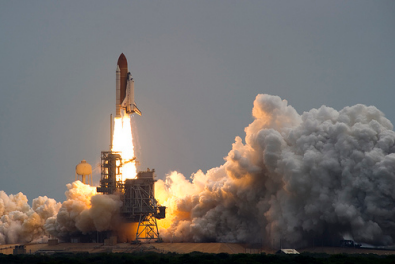Date Posted: August 30, 2011
Print Edition: August 25, 2011
 This past summer on July 21, the world witnessed the end of NASA’s Space Shuttle program as the shuttle Atlantis returned from the 135th flight in the program’s history. Thirty years ago, the program was launched with the hope that it would eventually offer safe, affordable and frequent trips into Earth’s orbit. Though those goals never became a reality, the shuttle program did contribute countless developments in technology, and inspired generations of people to think and reach towards the stars. So as the summer draws to a close, let us reflect for a moment on some of the past, present and future results which NASA and the shuttle program have, and possibly will yet offer the world.
This past summer on July 21, the world witnessed the end of NASA’s Space Shuttle program as the shuttle Atlantis returned from the 135th flight in the program’s history. Thirty years ago, the program was launched with the hope that it would eventually offer safe, affordable and frequent trips into Earth’s orbit. Though those goals never became a reality, the shuttle program did contribute countless developments in technology, and inspired generations of people to think and reach towards the stars. So as the summer draws to a close, let us reflect for a moment on some of the past, present and future results which NASA and the shuttle program have, and possibly will yet offer the world.
PAST
The shuttle program has made possible the development and maintenance of many satellites orbiting the Earth, most notably the International Space Station (ISS), the Hubble Space Telescope, and the Chandra X-ray Observatory. The ISS is a research facility currently being constructed about 400 km above the Earth’s surface. Continuously, for the past 10 years, there have been human beings living on the space station, and the space shuttle program has been vital in transporting crew and supplies back and forth from the ISS. The ISS houses many research projects investigating the effects of low gravity on biological systems; it also monitors and collects large amounts of data regarding the Earth’s climate and seismic activity.
While the ISS studies and explores areas relatively near to home, orbital satellites such as the Hubble Space Telescope and the Chandra X-ray Observatory have been instrumental in the discoveries and breakthroughs regarding the nature of our galaxy and the rest of the universe. By placing such observatories in orbit around the Earth, interference caused by the atmosphere is eliminated, allowing us to see better and further than we would from the surface of the Earth. Because of these observatories, scientists have been able to examine black holes, supernovae and countless celestial bodies, as well as phenomenon such as gravitational lensing and star formation. Observatories such as these have given people tremendous insight into the universe around us – and have provided us with extensive collections of pretty computer wallpapers.
PRESENT
The development of the space shuttles pushed the envelope of science and technology in the 1980s. Breakthroughs in science have always seemed to trickle down into the life of the everyday citizen. In fact, some vital technologies in use today were developed by NASA for use in the shuttle program. The NASA Spinoff Database is a publication of the technologies developed in part by NASA for use in the space program. From the artificial heart pump to Goodyear Tires and even cell phone cameras, there are many unexpected technologies that have resulted from the years of the shuttle program.
FUTURE
Now that the shuttle program has been discontinued, NASA has plans to travel further than ever before. Maintenance and construction on the ISS will continue – with Russia’s space program taking over where NASA’s shuttle program left off – but after sending many robotic rovers to the surface of Mars, NASA’s next long-term goal is to send a manned expedition into deep space. Far from the reaches of Earth, NASA hopes to be the first to put humans on asteroids, and eventually the surface of the Red Planet itself. As with the historic race to the moon, there may be competition. Not only are other countries looking toward the same goal, but the private sector is also beginning to rise up and push towards capitalizing on space travel, seeking to fill the void left by the space shuttles and perhaps even join the race to Mars. The private company Space Exploration Technologies (SpaceX) has already begun proposing a contract with NASA which optimistically places a launch to Mars in 2018.
The shuttle program and NASA’s work in space travel has inspired generations of future scientists and astronauts, contributed to many common and useful technologies, and helped to push forward our understanding of our own planet, as well as the rest of the universe. As to who claims the next landmark in the manned exploration of space – only time will tell.


